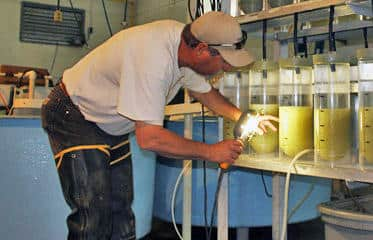Anglers, Walleye Benefit from Artificial Spawning in Kansas

Spring marks the beginning of spawning season for several fish species, but it also marks the start of artificial spawning for walleye. Kansas Department of Wildlife, Parks and Tourism (KDWPT) biologists and culturists will work tirelessly this season artificially producing walleye to stock state reservoirs and lakes.
This highly-prized sport fish naturally spawns during March and April when temperatures reach around 45-50 degrees Fahrenheit. Female walleye will typically lay their eggs in a rocky area during the night, secreting upwards of 300,000 eggs. Although females produce eggs in abundant numbers, less than 5 percent of their young will successfully hatch in the wild due to various environmental factors.
When conditions are right, fisheries biologists will work long hours at select Kansas lakes to capture spawning walleye. Eggs are taken from ripe females, fertilized, then delivered to the Pratt and Milford fish hatcheries where employees work around the clock to ensure the success of the walleye young.
A non-native species to Kansas, walleye were first introduced to Kansas waters in the 1960’s through the KDWPT walleye culture program. In addition to walleye, KDWPT also artificially produces bluegill, channel catfish, crappie, largemouth bass, redear sunfish, sauger, saugeye,smallmouth bass, striped bass, and wipers.
KDWPT also operates hatcheries located at Farlington and Meade, as well as a rearing pond at Woodson State Fishing Lake. These hatcheries produce approximately 39.5 million fry, 3.5 million fingerlings, and 385,000 intermediate fish each year.
For more information on KDWPT hatcheries, visit www.ksoutdoors.com and click “Fishing/Hatcheries.”

